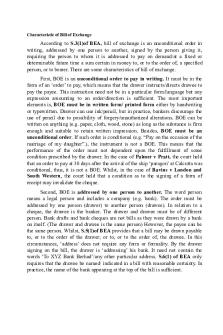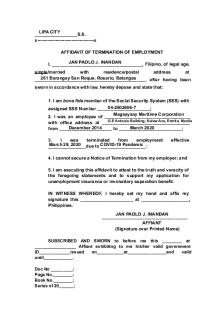Dangers of Speeding PDF

| Title | Dangers of Speeding |
|---|---|
| Course | Physics For Future Presidents |
| Institution | Suffolk University |
| Pages | 4 |
| File Size | 90.3 KB |
| File Type | |
| Total Downloads | 43 |
| Total Views | 199 |
Summary
Essay using math equations to compare two car crashes to see which is worse or if they would cause the same amount of damage. ...
Description
Essay 1: Dangers of Speeding When it comes to real world situations, the everyday person does not usually take physics into account. Whether they are driving, walking, riding a train, or flying in a plane, the dangers and destructiveness of an accident are not the first things to come across people’s minds. However, when breaking down the numbers of a 35 mph crash versus a 70 mph crash or a 600 mph airplane accident, it becomes clear that the differences are much more than one would think. Of course, there are outside factors that could affect these circumstances like weather, road conditions, and even the operator of the vehicle. Obviously crashing a car at 30 mph is not going to be as bad as crashing one at 70 mph, however, using physics, people will be able to understand the big differences between accidents. Using the kinetic energy formula,
1 K= m v 2 , we will be able to calculate the 2
difference of the two crashes being measured in joules. However, since there is no real way to know what the car’s mass is, an average car mass of 1200kg1 will be used for both the 35 mph car and 70 mph car for demonstration purposes and to show that 70 mph crash can, in fact, be four times worse than a 35 mph crash. Calculating the 35 mph car comes first. Inserting the numbers into the equation will make it look like
1 K= (1200)( 35) ² . Doing simple mathematics will give 2
you an answer of K = 146,886 joules. That’s a lot of energy. There is still one more car to find the energy for though. We only have to change one of the numbers, giving us and a final answer of K = 587,544 joules. 1 "Automobile." The World Book Encyclopedia. Chicago: World Book, 1996: 959.
1 K= (1200)( 70) ² , 2
Now all you have to do is a simple division or multiplication problem to see that it is plausible to say a crash of 70 mph is four times worse than a crash at 35 mph. Doing 587544/4 gives us an answer of 146886. A crash of 70 mph is, quite literally, four times worse than a crash of 35 mph even though it may not always seem that way to the naked eye. However, what happens when adding in factors like an airbag? Of course, the injury risk would be lowered, since airbags deploy the second a cat collides with a wall. However, the fact that a 70 mph crash being more deadly still stands as airbags can only do so much with the ay they are made. Airbags are the same in most cars today, with some being able to adjust for speed, therefore, they would all be able to only minimize risk to a certain, fixed, amount. I believe that airbags can only do so much because of the space that they are given. The bigger the mass of the car, the more room for bigger airbags. However, our roads aren’t always expanding to fit the need of today. They’re also filled with a gas that can only do so much. Since they can’t use anything else, airbags will always deploy at the same speed and cover the same ground, making their limitation a downside. Weather is another factor that can affect the crashes. Icy roads can make anything worse than it actually should have been. Rain and fog can make it harder to see for drivers, which also results in worse accidents. Finally, the driver being sleepy or under the influence of something can create an unfavorable situation. While this side of the problem at hand isn’t as scientific, it is important to note because an icy road can make the damage to the car and people inside much worse for a crash at 35 mph versus a crash into a fence on a flat, sunny highway at 70 mph. Kinetic energy applies to all moving things though. For example, planes generally move at around 600 mph when flying and around 150 mph when landing and taking off. When taking
planes into account, it makes a 70 mph car crash seem like nothing. However, one thing to remember is that cars crash into walls, stopping them instantly and creating fire, shrapnel, and other hazards. Planes collide with the Earth, but they have a chance to land in water, mitigating the damages to some extent. Using an average plane weight of 80,000kg2, we can use the kinetic energy formula to see how much energy is produced by planes to explain why there are so few survivors. Our formula for when a plane is flying would be
1 K= (80000 )(600 )² 2
with an answer of
2,877,760,000 joules. That is an insane amount of energy. Even when a plane is taking off or landing at 150 mph the energy produced is 179,860,000 joules. A plane that have accidents taking off or landing at 150 mph is about 1,200 times worse than a car crashing at 30 mph. And a plane crash at 600 mph is almost 5,000 times worse than a car crash at 70 mph. If there are few survivors for a car crash going at that speed, it is no surprise that a plane crash would yield so few survivors. In conclusion, crashes at any speed can be dangerous. There are always things that can influence the outcome such as weather, the operator, or even what the car or plane runs into. Using the kinetic energy formula, even though the speed of 70 mph is 35 mph doubled, the crash is four times worse, meaning everyone should take caution when driving at high speeds. The energy produced is even higher and, in a sense, worse when on planes where a 600 mph plane crashing was almost 5,000 times worse than a car crashing at 70 mph. Airbags can only do so much to alleviate some of the damages, but due to the gas they use and the limited space they have, they can only do so much. Energy is always working around us even though we may not 2 Boeing 737-800 - Aircraft Directory. (2017, April 21)
realize it and it may be in our best interest to take note of it sometimes....
Similar Free PDFs

Dangers of Speeding
- 4 Pages

Scope OF Sociology OF Health
- 9 Pages

Importance of Chain of Command
- 3 Pages

solution of mechanics of materials
- 1,597 Pages

Table of Muscles of Mastication
- 1 Pages

Benefits OF Maxims OF Teaching
- 5 Pages
Popular Institutions
- Tinajero National High School - Annex
- Politeknik Caltex Riau
- Yokohama City University
- SGT University
- University of Al-Qadisiyah
- Divine Word College of Vigan
- Techniek College Rotterdam
- Universidade de Santiago
- Universiti Teknologi MARA Cawangan Johor Kampus Pasir Gudang
- Poltekkes Kemenkes Yogyakarta
- Baguio City National High School
- Colegio san marcos
- preparatoria uno
- Centro de Bachillerato Tecnológico Industrial y de Servicios No. 107
- Dalian Maritime University
- Quang Trung Secondary School
- Colegio Tecnológico en Informática
- Corporación Regional de Educación Superior
- Grupo CEDVA
- Dar Al Uloom University
- Centro de Estudios Preuniversitarios de la Universidad Nacional de Ingeniería
- 上智大学
- Aakash International School, Nuna Majara
- San Felipe Neri Catholic School
- Kang Chiao International School - New Taipei City
- Misamis Occidental National High School
- Institución Educativa Escuela Normal Juan Ladrilleros
- Kolehiyo ng Pantukan
- Batanes State College
- Instituto Continental
- Sekolah Menengah Kejuruan Kesehatan Kaltara (Tarakan)
- Colegio de La Inmaculada Concepcion - Cebu









